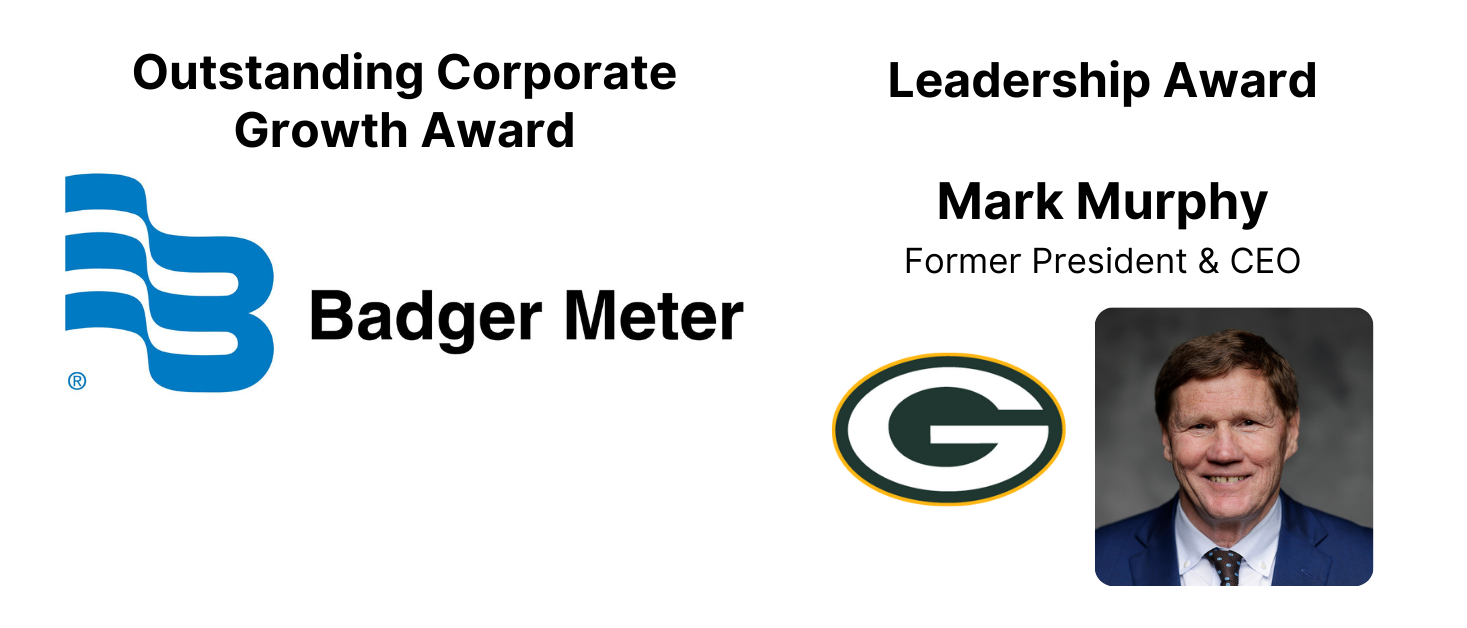
The Association for Corporate Growth – Wisconsin Chapter (ACG Wisconsin) is pleased to announce the recipients of the 2025 ACG Wisconsin Outstanding Corporate Growth Award and the 2025 ACG Wisconsin Leadership Award.
- Badger Meter has been selected to receive the Outstanding Corporate Growth Award.
- Mark Murphy, former President & CEO, Green Bay Packers, has been selected to receive the Leadership Award.
- ACG Wisconsin will celebrate the awardees during a luncheon on Friday, November 14, 2025.

ABOUT THE AWARDEES
Badger Meter
Badger Meter, a global leader in flow measurement, control, and communication solutions, has been named the recipient of the Outstanding Corporate Growth Award, recognizing the company’s exceptional performance, strategic expansion, and sustained innovation in the industrial technology sector.
Presented by ACG Wisconsin, the award celebrates organizations that demonstrate remarkable growth through strategic leadership, innovation, and market impact. Based in Milwaukee WI, Badger Meter was selected for its impressive revenue growth, strong operational execution, and commitment to long-term value creation for shareholders, customers, and communities.
“We are honored to receive the Outstanding Corporate Growth Award,” said Ken Bockhorst, Chairman, President and CEO of Badger Meter. “This recognition is a testament to the dedication of our employees, the trust of our customers, and our relentless pursuit of innovation in smart water solutions. We’re proud to play a role in enabling sustainability and resource efficiency across the globe.”
A leading innovator in flow measurement and control technologies, Badger Meter helps customers worldwide optimize operations and conserve resources. With a legacy of more than 120 years, the company delivers smart water solutions that provide actionable intelligence and help drive sustainability in water management. Over the past several years, Badger Meter has demonstrated robust growth driven by a steadfast focus on digital transformation and customer-centric innovation, expansion of its smart water offerings, and strategic acquisitions.
The company’s continued investment in R&D, its global footprint, and a resilient business model have positioned it as a standout leader in the industrial technology space. The Outstanding Corporate Growth Award adds to a series of accolades recognizing Badger Meter’s consistent financial performance, commitment to employees, environmental stewardship, and leadership in the evolving smart water industry.
Mark Murphy, former President & CEO of the Green Bay Packers
Mark Murphy, former President and CEO of the Green Bay Packers, and the first executive in residence at UW-Green Bay, has been named the recipient of the ACG Wisconsin’s Outstanding Leadership Award, recognizing his exceptional vision, integrity, and enduring impact as a transformative leader in both professional sports and the greater Wisconsin community.
The Outstanding Leadership Award honors individuals who exemplify strategic foresight, servant leadership, and a commitment to excellence. Mark Murphy was selected for his distinguished leadership of one of the NFL’s most storied franchises and for his lasting contributions to the organization, its fans, and the region.
Since taking the helm in 2007, Murphy has overseen a period of remarkable success, including a Super Bowl XLV championship, major infrastructure projects like Titletown and Lambeau Field enhancements, and record-setting fan engagement. Under his leadership, the Packers have become not only a model NFL franchise but also a powerful driver of economic and social impact in Green Bay and beyond.
“I’m deeply honored to receive the Outstanding Leadership Award,” said Murphy. “This recognition reflects the hard work and passion of everyone in the Packers organization, our loyal fans, and the entire Green Bay community. It’s been a privilege to serve a team with such a rich history and bright future.”
Murphy, a former NFL player, attorney, and college athletics administrator, has announced his retirement in 2025, marking the end of an extraordinary chapter in Packers history. His legacy includes a strong foundation for future growth, a vibrant community around Lambeau Field, and a sustained commitment to the values of excellence, teamwork, and integrity.
ACG Wisconsin will celebrate the awardees on Friday, November 14, 2025 at 12:00 p.m.

Register by January 14 to lock in the lowest rate and join 3,200+ dealmakers in Las Vegas on April 27-29, 2026.
